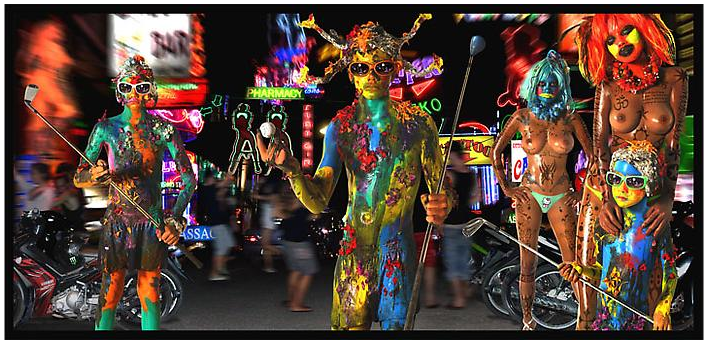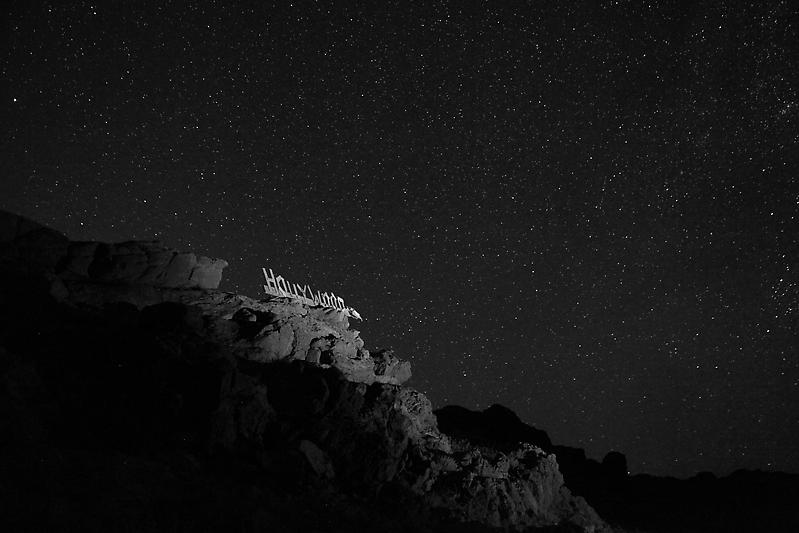
Ashley Bickerton, "TITNW7" (detail), 2010-2011. Acrylic, digital print and plastic laminate on wood. Courtesy Lehmann Maupin Gallery.
In his recent show at Lehmann Maupin Gallery in Chelsea, Ashley Bickerton, a founding member of the 1980s “Neo-Geo” movement alongside Jeff Koons and Peter Halley, continued his exploration of the Western fantasy perspective of the Far East. In his latest series of paintings and C-prints, Bickerton focused in on the debaucherous side of the Western imagination, crafting dystopic back-alley worlds set somewhere in Southeast Asia and lit by tawdry neon signs, strip clubs, and sex shops and populated by scantily clad, hyper-sexualized bodies, Western transients and sex tourists. Having left the United States and moved to Bali almost twenty years ago, Bickerton is something of a postmodern Paul Gauguin, insofar as the subject of his paintings is not the alluring exoticism of the mysterious East as constructed in the Western imagination, but rather the underlying and sordid impulses of the fantasy itself.
The fascination with and fetishization of the East by the West is something of a point of departure for the artists in Catch the Moon in the Water: Emerging Chinese Artists at James Cohan Gallery, located just across the street from Lehmann Maupin. Curated by Shanghai based Leo Xu, Catch the Moon takes its title from the verse of a Song Dynasty poem, “Seize the flower in the mirror, catch the moon in the water.” A mediation on the futility of capturing the real through its representation, the poetic verse in the context of this exhibition alludes to the stereotypes that have come to define (and be reflected in) contemporary Chinese art to Western audiences as part of the West’s preoccupation with the emerging cultural, military and economic juggernaut of China itself, including images of Mao, the Red Guard, Chinese characters, and other cultural objects and symbols. Turning this intersection of the real and fantasy inside out, the Chinese artists in Catch the Moon instead reveal their own imaginings of the West, mining the ways in which America and American art in particular have served as inspirational sources in their own creative process and maturation. The presence of such influences in the works on view are at times direct, but more often they are oblique and remote, filtered through dense layers of cultural and political scrims and across great social and geographical divides.

Cheng Ran, "Ghost of Tundra #2," C-print, 2010. Courtesy James Cohan Gallery.
There are many references to art and popular cultural imagery that have permeated the Chinese creative subconscious, be it an iconic Andy Warhol portrait and images of the twin towers with smoke pouring from them culled from print media, or the enduring allure of Hollywood and cinema’s role in both reflecting and shaping the image of America in the minds of people outside it. The artists Cheng Ran and Chen Wei both craft exquisitely staged photographs steeped in cinematic romance and mystery, an aesthetic that suggests the impact of both Hollywood culture industry and the work such American photographers as James Casebere and Gregory Crewdson.
But there are also more nuanced references to America’s influence in Catch the Moon, as well as works that reflect upon the complicated realities and challenges facing emerging artists working in China at a time when Chinese contemporary art is being ravenously consumed by Western audiences. One of the most poignant is Hu Xianqqian’s Xiangqian’s Art Museum (2010), a video performance in which the artist stands in a courtyard before a microphone and describes (in Mandarin with English subtitles) a series of Western art works that he remembers and considers influential to his own practice. While he recounts the works with great energy and enthusiasm, bouncing and pacing back and forth and speaking passionately, Hu’s descriptions of iconic performances pieces by the likes of Richard Long and other western artists are decidedly imprecise and vague and as his own performance unfolds, his work becomes less about the specific works that have influenced him and instead a meditation on the power and the limitations of memory, and on the ways political realities and cultural divides can complicate access and confound artistic discourse. Implicit in Hu’s work is the lack of resources and quality reproductions of the Western contemporary art that have so inspired and impacted his own work, yet which he had never actually seen or entirely comprehended—a “lost in translation” effect that goes beyond simple language barriers to subtly address the general lack of translated materials and his limited access to other art resources, both online and off. More hopefully, however, Hu’s Art Museum also speaks to how art has and can in its own way find a way to overcome those same political realities and cultural divides, influencing and inspiring against considerable odds and in unforeseen ways.

Hu Xiangqian, "Xiangqian's Art Museum" (video still), 2010. Single channel video with sound. Courtesy James Cohan Gallery.
The most memorable work in the exhibition is Double Fly Art Center’s video Contemporary Business (2010). In Contemporary Business, the members of Double Fly Art Center, a Shanghai-based collective, parodies a catchy Mandarin pop song, Love Business (Ai Qing Mai Mai), singing and dancing before a handheld video camera. Contemporary Business is part music video and part low-budget YouTube clip, at times revealing carefully choreographed moves and at others a snapshot of informal and seemingly spontaneous moments. The members of Double Fly dance and sing their way across Shanghai, singing about penises, breasts, and sexual encounters in one verse while deriding the artistic and curatorial limitations placed on them by an unidentified authority in the next.
[youtube:https://www.youtube.com/watch?v=1J5KJ5nlryk]
The backdrops in Contemporary Business seem carefully chosen to reflect upon Shanghai’s and China’s complicated past, its rapid present transformations, and its undecided future, as the merry band of outsiders groove in front of a massive, drab communist style housing project, dance on the Bund along Shanghai’s Huangpu River, a vibrant promenade lined with handsome Neo-Classical, Beaux-Arts and Art-Deco buildings (former banks and financial houses from the 19th and early 20th centuries) that are beautiful relics of Shanghai’s colonial past and emblems of the city’s cosmopolitan present. The Double Fly collective also playfully line dances against the backdrop of the iconic Pudong skyline, whose breathtaking array of buildings includes the futuristic Oriental Pearl Tower and two of the tallest buildings in the world (the mighty Jin Mao and the Shanghai World Financial Center): an ultramodern skyline that hides the fact that less than twenty years ago that section of Shanghai was largely undeveloped farmland.
Double Fly Art Center’s low-budget video aesthetic also speaks to other transforming realities, most notably the international character and freedoms of YouTube videos and low-tech music videos. In the hands of Double Fly Art Center, the music video/ YouTube format isn’t simply the latest way of packaging content, but an interface and an experience that signifies the accelerated pace of artistic innovation and creativity and represents a borderless generational zeitgeist. Yet it is also a format that nevertheless encounters resistances and echoes the limitations decried in Double Fly’s song, as the egalitarian and theoretically boundary-free nature of social media and the internet is also a space of continued restrictions and crackdowns in China.
Catch the Moon suggests that a wind is indeed blowing, but unlike Mao Zedong’s famous proclamation that “The East Wind Prevails Over the West Wind,” or Bickerton’s own representations of a foul wind blowing east, this exhibition suggests that those winds are more variable, the movements of influences and inspirations anything but unidirectional or straightforward. What is certain is that the developments will be fun to watch as contemporary Chinese artists continue to reflect on their place in their own rapidly transforming society, and in the world at large.
Catch the Moon in the Water: Emerging Chinese Artists at James Cohan Gallery is on view until July 29, 2011.



